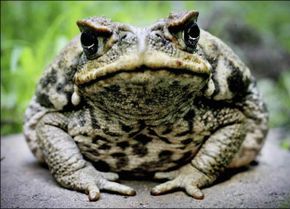Quck answer
The Cane Toad is a large, poisonous toad native to Central and South America. It was introduced to Australia in 1935 to control beetle populations but has since become an invasive species and ecological threat. Cane Toads can grow up to 9 inches long and weigh over 4 pounds. They have dry, warty skin and produce a toxic secretion that can be deadly to predators. Despite efforts to control their population, Cane Toads continue to spread and threaten native species.
Wild Animals

Cane Toad
Getty Images
The Cane Toad is originally from Central and South America. However, it has become an invasive species in Australia since it was introduced there in 1935 to protect crops against cane beetles. Unfortunately, the experiment failed because the toads don’t eat adult beetles and the larvae, which they would eat, live underground. This resulted in the Cane Toad reproducing uncontrollably and causing harm to the native wildlife.
Due to the Cane Toad’s poisonous nature and the lack of natural predators in Australia, native predators that occasionally feed on the toads end up dying themselves. With numbers in the millions (originally introduced with just 3,000), the Cane Toad is continuing to expand its reach in Australia, pushing local snakes, lizards, and other animals to the brink of extinction.
A bulky amphibian, the Cane Toad has dry and bumpy skin with ridges above its eyes. It prefers living in grasslands and woodlands, only moving to fresh water to breed.
FAQ
1. What is a Cane Toad?
A Cane Toad is a large, terrestrial amphibian that is native to Central and South America. They were introduced to Australia in the 1930s as a biological control for sugar cane pests, but have since become a major pest species themselves.
2. How big can Cane Toads get?
Cane Toads can grow up to 9 inches in length and can weigh up to 4 pounds. Females are typically larger than males.
3. What do Cane Toads eat?
Cane Toads are opportunistic feeders and will eat almost anything they can fit in their mouth, including insects, small mammals, birds, reptiles, and even other amphibians. They have a voracious appetite and are known to eat to the point of bursting.
4. Are Cane Toads poisonous?
Yes, Cane Toads are highly toxic and can be deadly to predators that attempt to eat them. They secrete a milky white toxin from glands on their back that can cause convulsions, paralysis, and even death.
5. What is the impact of Cane Toads on the environment?
Cane Toads have had a devastating impact on the Australian environment since their introduction. They compete with native species for food and habitat, and their toxic secretions have killed many native predators, including snakes, lizards, and crocodiles. They have also caused declines in populations of native frogs, which are often mistaken for Cane Toads and killed.
6. Can Cane Toads be controlled?
Efforts to control Cane Toad populations in Australia have been largely unsuccessful. Methods such as trapping, fencing, and poisoning have had limited success and can also harm non-target species. Research is ongoing to find more effective and humane ways to control Cane Toads.
7. Are Cane Toads found anywhere else besides Australia?
Yes, Cane Toads have been introduced to many other countries, including Fiji, Papua New Guinea, and the United States. They are considered an invasive species and have had negative impacts on native ecosystems in many of these locations.





Leave a Reply